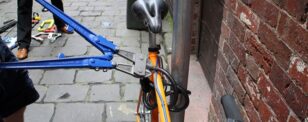Tasmania Police do not publish statistics on stolen bicycles, but Bicycle Network has been contacted by several people recently who believe electric bicycles are being targeted by thieves.
Of particular concern is organised thieves targeting areas such as university campuses and the Hobart city centre.
When contacted for comment about bike thefts, Tasmania Police said it “recommends purchasing high quality bike locks to secure high cost bicycles or store the bicycle inside”.
So, basically, if you don’t want your bicycle stolen, it’s up to you to protect it.
Electric bicycles
Some owners of e-bikes may be lulled into a false sense of security about the bike’s weight and wheel locks being a deterrent to theft.
However, neither is effective if the bike can be carried away.
This happened to one unhappy rider in Hobart whose bike went missing outside the Cat and Fiddle arcade several weeks ago. CCTV footage showed two men simply picking up the bike and walking away with it.
Another person recently had her e-bike stolen from outside the Hobart Library. While she had locked it up, it was only a cable lock, which can be easily cut. Two more e-bikes have reportedly been stolen from the busy Elizabeth Mall in the past few weeks.
Lock it
While all locks are ultimately breakable, using sturdier locks may deter some thieves.
Our 2016 review of bike lock styles is still very relevant today. The review analyses how long it would take someone with a portable angle grinder or bolt cutters to cut different types of locks.
D-locks and heavy chains with good padlocks are the most secure because they need two cuts, but they are also heavy to carry and d-locks have poor flexibility.
Folding locks are becoming more popular for their security and flexibility but only require one cut to steal.
Wheel locks are difficult to break but you still need to lock your bike to something so it can’t be carried away.
Most other types of locks, such as cable and combination locks, are less secure and should be avoided.
Park it
If you are locking up your bike in public rather than at home, try to find somewhere highly visible that has a lot of foot traffic. Thieves may be less likely to try and break a strong lock in a public place as they may attract attention to themselves, especially if having to used an angle grinder.
Some off-street car parks run by councils offer bicycle parking in locked cages or within view of attendants.
And make sure your bike is locked up at home, either inside or in a secured shed.
At major events like the Taste of Tasmania or the football at Bellerive, use Bicycle Network’s free valet parking service for extra security.
Register it
One way of helping to track stolen bikes and identify them when retrieved is Bike Vault: https://www.bikevault.com.au/
You can register your bike on the site and include photos and information to identify you as its owner.
The site provides tips on what you can do if your bike is stolen, including where to look for sale adverts that may identify the thief. Adverts for bikes for sale on Gumtree and Ebay are collated on the Bike Vault site and are searchable.
It also includes the ability to search police listings of stolen bikes that have been recovered. For Tasmanian bikes this is important as expensive bikes may get taken interstate for sale, although Tasmania Police also lists local bikes on the site.
The site should be the first stop for anyone considering buying a second-hand bike to ensure they are not buying stolen goods.
Bike Vault sells ID kits for your bike or you can get the bike’s serial number or some other means of identification, such as your licence number, engraved on to your bike to help identify it if recovered.
Report it
Make sure you make a statement to Tasmania Police so your bicycle theft is recorded as an offence. That will make it easier for you to claim the bike if you see it being advertised and will make it easier for police to find you if they recover your bike. It may also mean you need to go to court if the thief is found to make a statement that the bicycle is yours.


